When Plan A – and Plan B and Plan C – Do Not Pan Out
May 2nd, 2014
“The summit is for the ego and the journey is for the soul.” (origin unknown)
These were the words of our lead guide, Thomas Greene, of Sierra Mountaineering International, as we wrapped up our gear issue in the parking lot of the Dow Villa Motel in Lone Pine, California.
Mt. Whitney, the tallest mountain in the Lower 48 states, and the mountain we had come to climb, loomed in the background.
I loved Thomas’s quote, and vowed to remember it for a future time when it would come in handy, such as in a speaking presentation, or during a future coaching session. At the moment, its relevance eluded me.
Months earlier, I began assembling a group of intrepid men and women to embark on a Mt. Whitney mountaineering trip. It marked the first co-ed epic adventure for Epic Life. Leann, Karla, Chuck, Helen, Craig, Cutter, Grant, Jackie, Jenni and Sonja came from near and far to climb the mountain.
Our backpacks loaded, we convoyed to the Whitney Portal trailhead, and started up the trail. Our plan (Plan A) was to hike to Lower Boy Scout Lake for the first night, then on Day 2, advance to High Camp, from which we’d make our summit bid, and at which we’d spend 2 nights.
The first mile is a nice, well-used trail, and as is typical, and wonderful, the members of the group started conversing and discovering more about each other. At the one-mile mark, we refilled our water bottles from a creek, and received some lessons from the guides about pressure breathing, and the “rest step,” both of which would be useful during our mountaineering adventure.
At this point, we left the hikers’ trail and started what is commonly referred to as the Mountaineers’ Route. We hiked over a rough trail and through some deep-and-soft snow. At times, a leg would post-hole to the knee or lower thigh. Otherwise, so far so good. The day was a stellar one. Bluebird sky, chirping birds and inspiring scenery.
Next up would be The Ledges. I knew from my experience climbing this mountain last year that The Ledges would be one of the most notable features of Day 1’s backpacking.
The Ledges represent a section where we use hands and feet to scale our way up over some cliffs. The “ledges” are narrow, but plenty wide. It is the exposure and what if’s that make it exhilarating. Our mind wouldn’t be free while scaling the ledges. We’d need to be focused in order to stay safe. Other than that, The Ledges are a blast to ascend, and I knew that the members of our group would either love them or at the very least, find them memorable.
From The Ledges, we continued up a pretty steep trail. One of our guides, Zach, stopped us to point out a “lenticular” cloud that we could spy over the tall granite mountains ahead of us. He said something to the effect of “That means change is coming.”
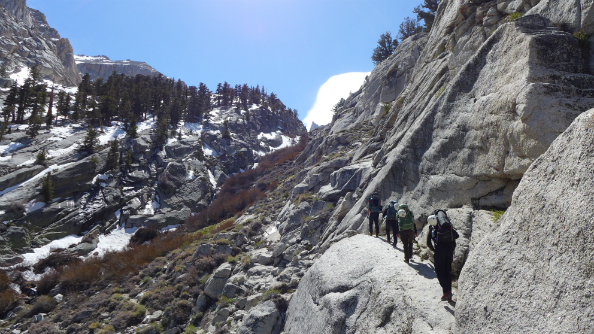
Hiking toward Low Camp. Note the lenticular cloud ahead and over the tall granite mountains we were heading for.
We were all aware that the weather forecast for our four days was not ideal. It called for “unsettled” weather, including an 80 percent chance of snow, and high winds for Day 2, and into the morning of Day 3. We weren’t thrilled about this, but we also knew that the weather in the high Sierras is highly variable and that the forecast could be wrong. As we made our way toward Mt. Whitney, I was hoping the forecast would shift in our favor.
By mid afternoon, we arrived at Lower Boy Scout Lake, which would be our home until the next day. We set up our tents, and got ready for a demonstration of a very important skill required on a Mt. Whitney mountaineering adventure – How to Poop in a Bag.
“Wag Bags” are a requirement if you want to climb Mt. Whitney. And, although this is something many cannot fathom doing, can you imagine if it weren’t a rule and people could just go #2 anywhere? The result would be unacceptable and awful for all kinds of reasons that you can surely imagine. So, we dispose of our human waste in a bag…
As I handed off the teaching of this skill to the guides, I emphasized to the group, “Trust me, if you can poop in a bag, you can climb any tall mountain. (And, no, this would not be a live demonstration!)”
I wish I would have captured photos of the looks on some of the members’ faces as they learned how to manage bowel movements in the high country, but I didn’t. Next we enjoyed some soup and hot beverages before snarfing our dinner – epic burritos with extra beans. (Just kidding!)
Our camp site was extraordinary. The evening was cold, but clear and beautiful. And even though I live in the Wind River mountains, which are in many ways similar to the Sierras, including the fact that the weather can change in an instant, I found it hard to believe that our stellar conditions were about to change so dramatically.
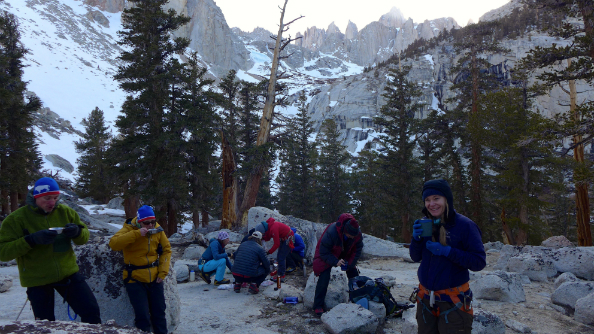
Our first evening at camp was a little chilly, but otherwise amazing, complete with great company, a clear sky, extraordinary scenery.
I awoke early the next morning, and walked to the back of our camp to get a look at where we had come from the day earlier. I was greeted by a breathtaking sunrise. Despite the unfavorable forecast for the hours ahead, the sunrise gave me hope.
By breakfast time, it was obvious from the weather that our Plan A was out. By 9am, as Mt. Whitney and the surrounding peaks started to go behind a white curtain, we started battening down the hatches, and our plans to advance to High Camp faded.
When I coach my clients, I often challenge them to consider the question, “What if Plan A doesn’t work out?” I value this question, and use it in my own life on many occasions. The value of doing so lies in the fact that Plan A often does not pan out, and it’s better to have a Plan B than to give up if Plan A doesn’t work. In fact, I’ve had some Plan B’s that turned out better than my Plan A could have possibly turned out.
Nevertheless, as Thomas and the guides explained the dangers of advancing, setting up camp, and living exposed at 12,000′ in gale force winds and a blizzard for the next 24-plus-hours, I silently cursed the Universe for driving home this point about Plan A not always working out, which, for the record, I already was well practiced in.
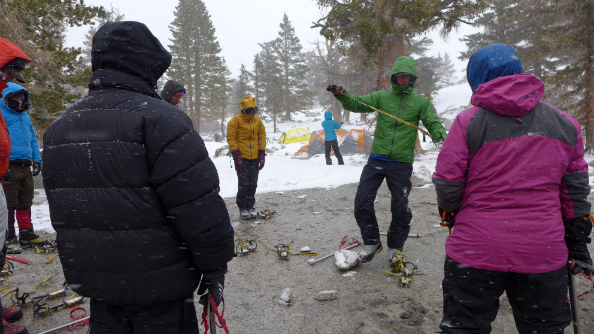
Since we couldn't advance to High Camp, we geared up to practice some skills we would need during our summit attempt.
Our new plan (Plan B) was to hope for a break in the weather in the wee hours of the morning of Day 3 so that we could execute a summit attempt from our current location. It wasn’t ideal; it would make for a very long summit day. But we wanted to climb Mt. Whitney, and what other choice did we have?
As the morning wore on, wind blew through our camp and a blizzard dumped snow upon us. We did the only reasonable thing – we hunkered down in our tents. By early afternoon, though, we wanted out of our tents, so the guides taught us skills that would help us on summit day, including how to use an ice axe as a hiking stick on steep snowy terrain, how to self arrest, and how to hike with crampons on. We went for an uphill crampon hike in blowing snow. It felt good to move, and doing so warmed us.
Upon returning to camp from our hike, I sensed we were all feeling invigorated. We quaffed soup and hot beverages as Thomas instructed us on what we needed to have ready for our summit climb. We ate dinner and tried to be hopeful. The guides indicated that our best case scenario was for the weather to be clear at 2am, at which point we would be awakened, and we’d start our trek to the summit. He added that if the weather didn’t clear in the wee hours of the morning, then we’d hopefully still have a chance, although not an exceptional one, come 6am. (I considered the 6am start our Plan C)
As leader of this group I wanted my people to be comfortable and warm and rested, and I wanted for them to get a shot at Mt. Whitney’s summit.
Based on my experience that night in the tent with Sonja and Leann, as well as feedback shared by members of our group later, Night 2 was “noteworthy” for its challenges. As the one responsible for bringing everyone to this mountain, I was nervous and excited. I was certain I wouldn’t sleep, and the weather made sure I didn’t.
High winds hammered our tents all night long and carried, and dumped, snow on our camp. Every hour or so we’d shake the snow off of our tents. Even though we vented our tents, the snow worked hard to bury us and the result was condensation and water dripping inside our tents. The harsh conditions outside, combined with the restlessness inside, left us feeling uneasy. For my part, I lay there praying for strength, if not for a break in the weather.
Night 2 was a different kind of challenging for others in the group. I won’t name any names, but three people who were sharing a particular tent reported feelings of claustrophobia and unpleasant fumes. It is important to mention that the telling of this story by the aforementioned tent mates gets more humorous with each telling. And one of the members of the tent went as far as to say he is grateful for having had the challenging and unique experience of that night in their tent, because it is something he’ll never forget and will enjoy telling others about for years to come.
Another tent group had what one described as “something close to a slumber party.” We heard them giggling and making a loud request for wine, which I’m quite certain went unanswered. They shared snacks and applied various skin treatments. “Who knew we had the makings of an entire spa in our tent!” said one of that tent’s members when I asked her to recall Night 2.
But we weren’t having a party in our tent. I knew Leann and Sonja weren’t sleeping either. Have I mentioned it was a challenging night? On the upside, for a lack of other things to do, and because we could, we ate a lot of chocolate during the night. A lot, a lot. (File under #NotOurFault)
As I lay there trying to be strong and hopeful, 2am – and our Plan B – came and went. 3 am, 4am and 5am passed. Snow continued to fall and gusts of wind continued to blow. But then, around 6am, as if by a miracle, the snow had stopped falling, and the wind had stopped blowing. At our wake-up, we were greeted by a snow-covered camp and most importantly, a clear, blue sky above. Could our Plan C be possible? I wondered, with optimism.
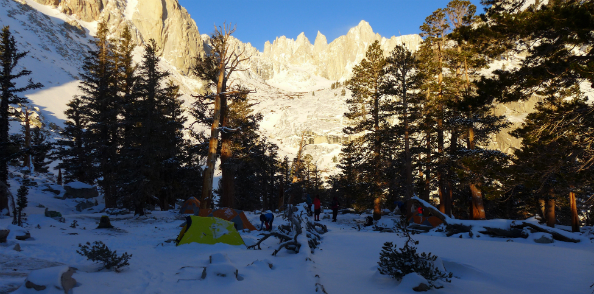
The scene at morning of Day 3. We were snow-covered, but it was a clear and stellar day. A summit attempt, although it would be a hardy one, seemed possible.
It was a cold but spectacularly beautiful morning. Eager for coffee and tea, we huddled around the stove as it boiled our water. Our guides informed us that they hiked a ways above our camp and snow was deep but not problematic. However, the conditions up high were likely unstable, and high wind gusts were predicted up top. Plan C was out.
Our last remaining option (what I will call Plan D) was to not summit Mt. Whitney, but to take an optional uphill hike to Upper Boy Scout Lake, then return to Low Camp, dismantle camp and hike down the mountain. Most of us did that, and it was an amazing excursion. As we hiked up, we passed two parties coming down. Both had attempted alpine starts for the summit, from higher elevations, and were turned around due to unstable snow and avalanche danger. Not that we needed it, but hearing their reports validated our decision to not go for it.
We had a great hike down the mountain under a blue sky before enjoying $5 showers at the Hostel in Lone Pine, some pizzas, beer and wine. We spent our third night camped in the famous, beautiful, and warm, Alabama Hills. We had a huge fire and slept under a star-filled sky. The morning of Day 4 was spent doing some scrambling with fixed lines, followed by a fun rappel – things that were in our original plan.
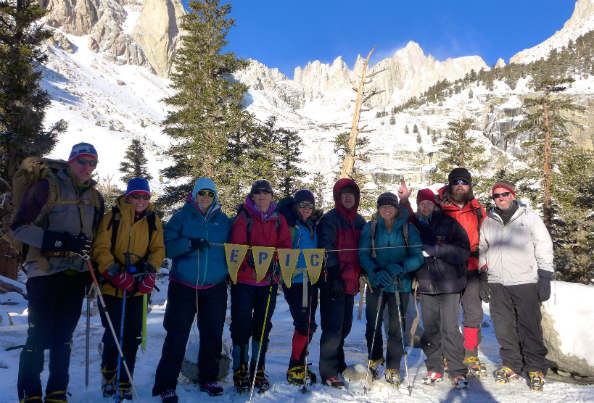
I was honored to share this adventure with an epic group of people. (Helen: I'm sorry you are not in this picture!)
Since our return on April 28, I have found myself reflecting on our Epic Life Mt. Whitney adventure. While we didn’t stand on Mt. Whitney’s summit, we did go mountain climbing.
I wanted our group to stand on Mt. Whitney’s summit and for our group to not risk our lives. We accomplished the most important of those two objectives. For me, the adventure, which provided lessons in leadership and humility, as well as a lot of fun, will remain an unforgettable and amazing memory.
And as someone who climbed to Whitney’s summit one year ago, I have come to the conclusion that not summiting the mountain was more difficult than summiting it, which is ironic. Not summiting due to things we couldn’t control was not only harder to accept, but harder to do. As a result, this year’s unsuccessful summit effort will likely be more informative in my life and work than the successful summit bid in phenomenal weather last year. I wouldn’t trade either experience.
I often remind clients, and audiences I present to, that an epic life is not an easy life. I tell them that an epic life is full of mountains and hills to climb, including those we put there and those we don’t put there but that nevertheless must be climbed, if we are to become actually what we are potentially.
And then, for the first time since the start of our adventure, I remembered the quote Thomas shared at the outset: “The summit is for the ego, the journey is for the soul.”
Indeed.
A special thank you to Leann, Karla, Chuck, Helen, Craig, Cutter, Grant, Jackie, Jenni and Sonja for signing up. Thank you to our awesome guides, Thomas, Lyra, Lindsay and Zach, and to Kurt Wedberg and Sierra Mountaineering International. Thank you to Sonja’s mom and grandparents for their yummy treats and support pre- and post-adventure. And finally, thank you to Jerry (my best half), and to our three sons for their loving support as I develop this business and frequently find myself away from them camped in faraway mountains.
- Categories: Adventure, Fitness, Life and Leadership, Travel
- Tags: epic adventure, epic life, high sierras, mountaineering, mt. whitney
- Comments: 7 Comments

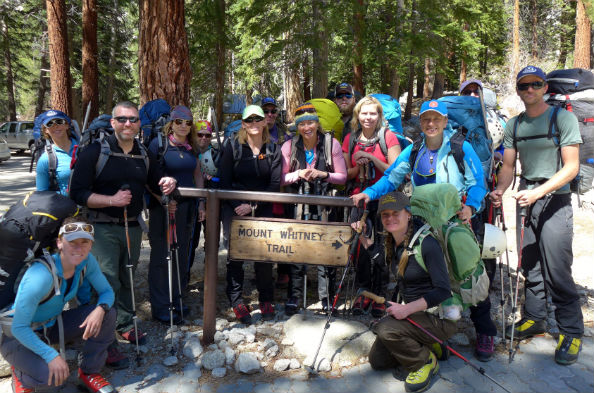
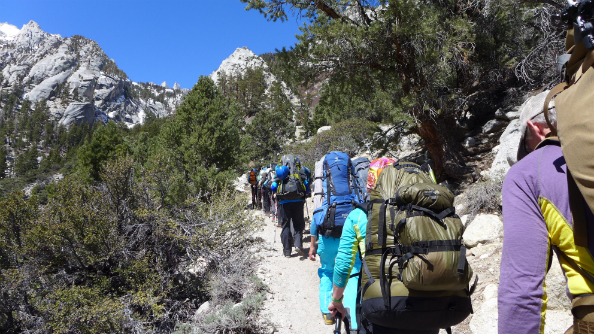
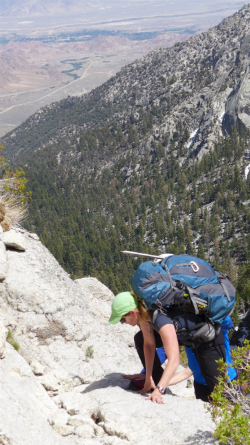
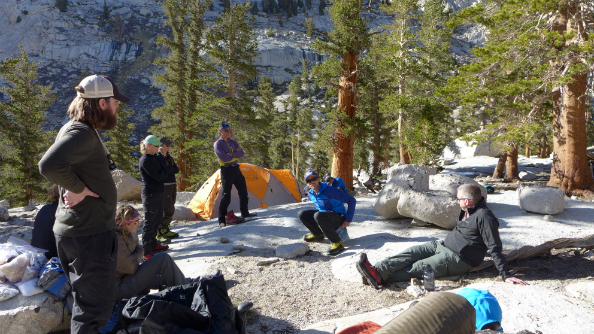
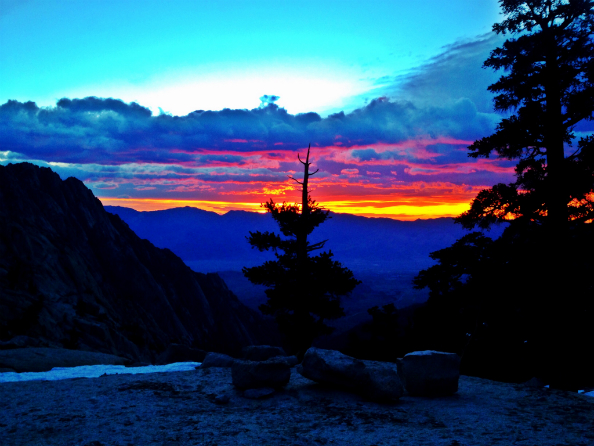
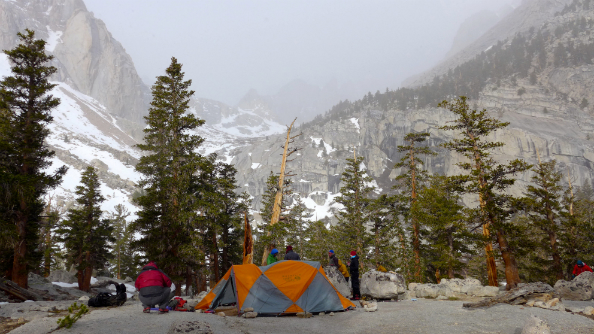
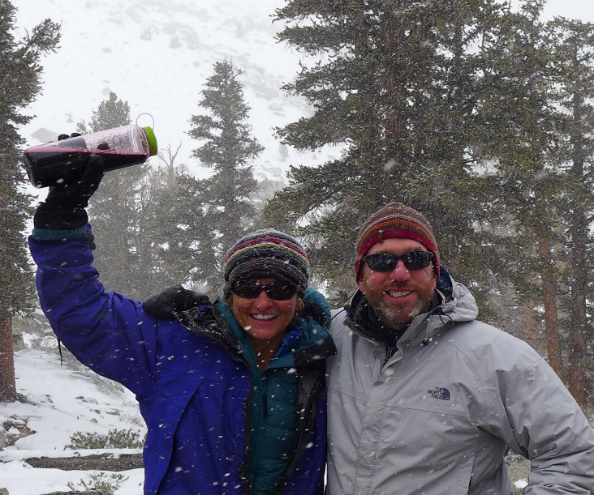
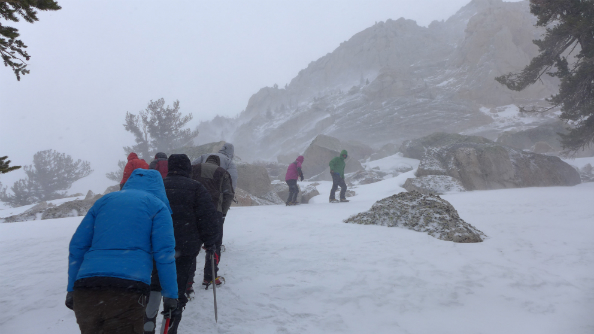
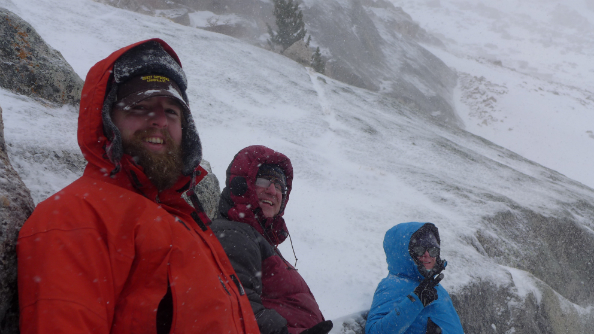
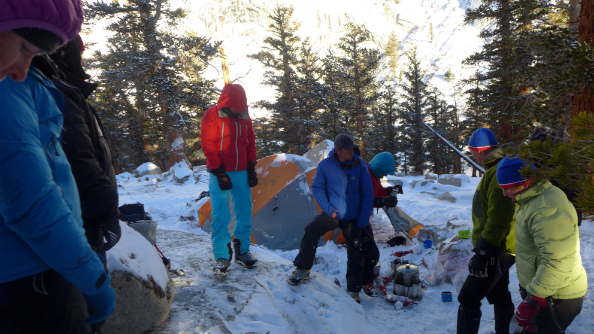
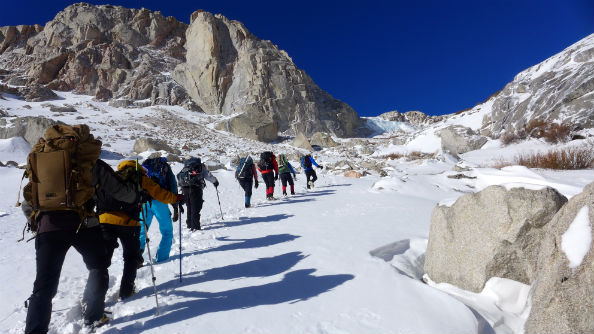
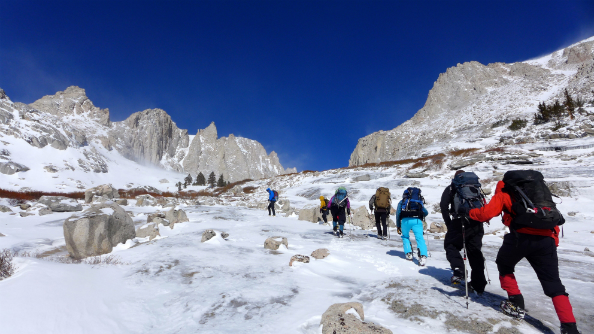
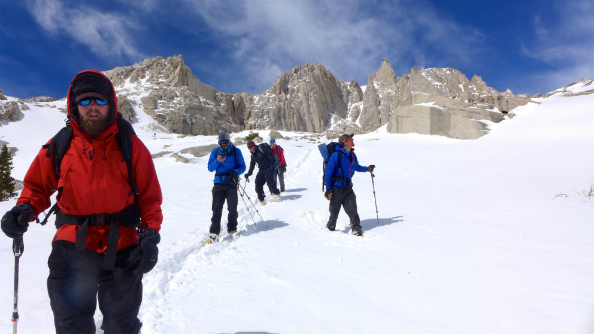
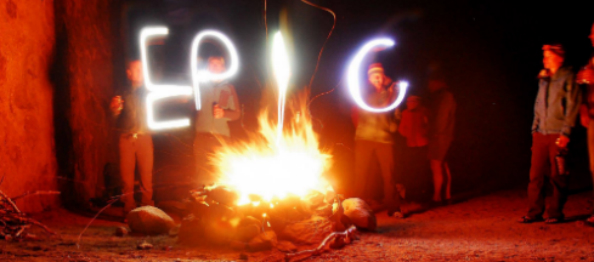





Shelli…a BIG Congrats to you and Your Team for giving it all you could…Safety is and always should be Number 1…it’s not always easy but as Thomas’ quote says……”the Summit is for the Ego, the journey is for the Soul” THANK YOU for allowing us to share a spot in the SOULS of ya’ll !! God Bless and may you have many more Peaks to climb !
It was quite an adventure, and in spite of not making the summit, a very rewarding one. To my fellow climbers, and wayfarers in this wide open world I want to say thank you for letting me share this experience with you. I’m sure our paths will cross again, on this mountain or another. Shelli, thank you for writing this, it’s amazing!
OMG the lack of sleep you all had to be performing under. That’s epic.
Thanks all! Sharon, for what it’s worth I/we were well rested before and after Night 2. Yeehaw to that!
As usual, it sounds wonderful and I too will learn from just your writing of this. Congrats to everybody for an incredible experience that I’m sure will stay with them forever.
Thank you for documenting the journey in such wonderful storytelling, Shelli, and for sharing the lessons learned, especially the quote “The summit is for the ego, the journey is for the soul.”
Shelli, thanks for setting up this big adventure and inviting me on it. I remember taking Thomas’ “summit is for the ego” statement to heart, especially as I was struggling with a bad cough. I didn’t know what was possible so I liked that I could focus on the journey. Well a couple things happened on the way. First, I had a total blast – I really enjoyed the whole thing, even the snow and the wind howling in our tents. How come food tastes so good out on the sides of mountains in the cold anyway? Second, by not being able to try for the summit, I have gotten more committed than ever to getting there. In almost a month since our adventure on Whitney, not a day has gone by that I haven’t thought or dreamt about it. I need to go back! Thank you Shelli, Thomas, Lindsay, Lyra and Zack for making it a great trip!!